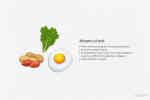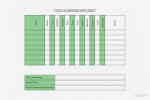Step 4 of 5•8 minutes read
ALLERGENIC Contamination and Control
Food allergens are an increasing problem in the food industry. Your shipping company will have an allergen policy in place to define the qualifications and expertise required for those in control of allergenic products plus the processes and procedures to be followed on board.
The HACCP team will have control measure in place but it is very likely that there is at least one individual on board who is responsible for allergen management.
Food labelling legislation came into force in 2013, the video below explains the controls to be put in place under this legislation. As a supervisor, you are required to check the system is working by observation and monitoring. As supervisors, you are also required to ensure your teams are asking passengers about any allergies or intolerances to food to prevent any food safety issues. Offering choices on alternative foods that are available and safe for them to eat.
Always ensure your team know what they can ask, who to ask and when they should ask for help with allergen guidance.

Symptoms of Allergic Reactions
Even the tiniest amount of an allergen can cause a reaction with some people being more susceptible. Below is a list of symptoms of allergic reactions.
- Shortness of breath/wheezing,
- Swelling of tissue in the mouth and throat,
- Difficulty in swallowing and speaking,
- Severe asthma,
- Cramps/gastrointestinal symptoms,
- Generalised flushing of the skin,
- Rash/hives,
- Alterations in heart rate,
- A sudden feeling of weakness,
- Collapse and unconsciousness, and
- Death.
There is a difference between a food allergy and food intolerance.
A true food allergy causes an immune system reaction that affects numerous organs in the body and it can cause a range of symptoms. In some cases, an allergic food reaction can be severe or life-threatening. In contrast, food intolerance symptoms are generally less serious and often limited to digestive problems.
Food allergic reactions can be very serious and controls must be put in place throughout food production from farm to fork.
Watch this video to learn more about the most common food allergens.
The Common Allergens
To recap from the video, here is an image of the allergens that you are required to know. Always keep yourself updated in case more allergens emerge and have to be identified as part of food safety management.

Allergens
As mentioned in the video, all food handlers should be aware of the allergens in food. A good practice is to have one person responsible for allergens and food items that guests and crew may be intolerant to. However, if you are a service crew you need to know the answer if a passenger asks you a question about allergenic ingredients. If it is not detailed on the menu or labelled on the buffet, there needs to be a clear procedure so that a correct answer can be given quickly.
Below is an example allergen data sheet that can be produced for all dishes. This clearly outlines the allergens in each and can be communicated to the food service crew.
Menus can have allergens labelled and signage on buffets can inform passengers and crew.

Food allergens data sheet.